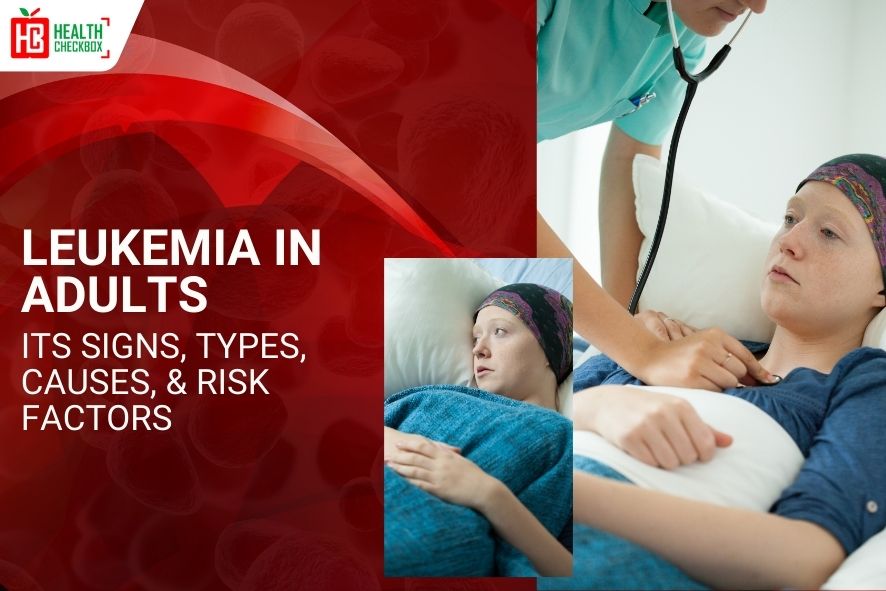Leukemia is nothing but a type of blood cancer that affects the human bone marrow and their blood cells. In this, the bone marrow rapidly produces the abnormal white blood cells that don’t function properly. It can affect both children and adults. Finding it in the early stage can help with effective treatment and faster recovery. Here in this blog post, we will explore some early signs of Leukemia in adults, why they happen, and when you should consider seeing a doctor.
You may notice your injury takes time to heal, and also feel tired or have frequent infections. Although these minor changes you ignore at first and take as an acute disease, sometimes they can be early signs of leukemia. Early detection of this blood cancer condition can have a great impact on the treatment process.
What is Leukemia?
Leukemia is a blood cancer that also includes bone marrow cancer in its definition. It disrupts the production of white blood cells (WBC), which are vital in fighting infections. Then, it is understood that faulty white blood cells are produced, thus not functioning normally when it begin developing as a cancer. Defective cells multiply uncontrollably, displacing normal blood cells, resulting in a weakened immune system.
Types of Leukemia in Adults
There are different types of leukemia, and some are common in children. While other types of this health problem are more common in adults. That includes:
- Acute Lymphoblastic Leukemia: ALL is a slow-growing leukemia that affects children and is often diagnosed in older adults.
- Acute Myeloid: AML affects myeloid cells and progresses quickly. Its characteristics typically affect children and older adults by reducing their normal blood cells.
- Chronic Lymphocytic: CLL is slow-growing and often diagnosed in older adults.
- Chronic Myeloid: This cancer develops slowly but can become aggressive over time. Chronic, accelerated, and blast crisis are the three main phases of CML.
The type of leukemia influences how symptoms appear and progress. However, most forms share some common early warning signs.
Cause of Leukemia in Adults
There is no exact cause of Leukemia, but scientifically, this health problem is caused by some genetic and environmental factors, which are given below:
- Genetic Factors: A family history.
- Leukemia
- Down Syndrome
- Mutations in the DNA of bone marrow stem cells.
- Environmental Factors: The factors that put some individuals at higher risk.
- Contact with intense radiation
- Exposure to certain chemicals, like benzene, etc.
- Contact with tobacco smoke
- Certain past cancer medical care
- Viruses like the Human T-cell Leukemia Virus
Early Signs of Leukemia in Adults
Identifying the early signs of leukemia can help to start treatment at an early stage and prevent from chronic or major disease. The primary signs of leukemia are similar of a viral infection, lots of stress, and a weak immune system. Here we explain the biggest indicators of lekumia factor, which are found in adults:
- Fatigue and Weakness: This is one of the most common warning signs of leukemia in adults. Resulting from low red blood cell count, you feel tiredness and lack of energy.
- Frequent Infections or Slow Healing: Because of weakened immune function, your body can’t fight off infection. This infection typically occurs in adults, manifesting as urinary tract and respiratory infections.
- Easy Bruising and Unusual Bleeding: Platelet deficiencies cause minor cuts to bleed for an extended period.
- Weight Loss and Loss of Appetite: It is common to lose weight for no apparent reason. You may experience regular weight loss without any changes to your lifestyle or diet. The abnormal blood cells can weaken your metabolism, which can be a reason for weight loss.
- Swollen Lymph Nodes: Enlargement of the lymph nodes in the groin, neck, or underarms.
- Persistent Fever or Night Sweats: Recurrent fevers can be brought on by a weakened immune function.
- Bone and Joint Pain: The bone marrow becomes filled with cancerous cells.
Test to Diagnose Leukemia In Adults
This blood cancer is diagnosed by examining bone marrow and blood samples. Some diagnoses and tests may include a review of medical history, imaging tests, and physical exams as well. Your doctor will conduct a few tests to determine this disease. If you have leukemia cells, as mentioned below all these tests may reveal the symptoms of blood cancer:
- Complete blood count
- Blood smear
- Flow cytometry
- Bone marrow aspiration and biopsy test
- Core biopsy
- Lumbar puncture
- Polymerase chain reaction
- Imaging and other tests, like chest X-ray, CT scan, or magnetic resonance imaging scan
Treatments of Leukemia In Adults
Medical care for this disease depends on its stages, a person’s age, health condition, and which type of leukemia you have. Here is a list of some common treatments which are frequently a combination of the following:
- Chemotherapy: Chemotherapy treatment is a way to treat leukemia cells with medication or injections. It is also called a cornerstone of leukemia treatment.
- Targeted Therapy: It is an alternative treatment that focuses on abnormal cancer cells, which promote their growth.
- Radiation Therapy: Radiation therapy is used when the cancer cells reach the central nervous system and when the stem cell transplant is planned.
- Stem Cell Transplant: Stem cell transplant is used when a high dose of chemotherapy is given to the patient. In this, a cancerous cell is replaced by new healthy cells.
- Immunotherapy: This therapy is the best option for boosting the immune system to fight against cancer cells. Sometimes, doctors suggest a couple of drugs that help to improve immune function, like monoclonal antibodies or checkpoint inhibitors.
Risk Factors of Leukemia
Several reasons that may increase the risk of developing leukemia include:
- People who have certain types of therapies for other cancers can increase the risk of leukemia.
- Genetic disorders seem to play a role in the development of this health concern.
- Chemicals, like benzene, may also increase the risk of blood cancer.
- The smoke of cigarettes may develop as a result of Leukemia.
- Your risk may be increased if your family member has been treated for this blood disease.
Prevention Tips to Reduce the Risk of Leukemia
It cannot always be prevented. But sometimes changes in lifestyle can reduce the chances of many cancers, including leukemia.
- Avoid smoking, tobacco, and harmful chemical substances because it is a major risk factors for many cancers, including leukemia.
- Eating always healthy and packed food can prevent you from infection and reduce the risk of leukemia.
- By doing regular physical exercise, you can prevent yourself from any type of infection or disease.
- Excessive alcohol can be a reason for several cancers. If drinking is chosen, it should be done in moderation.
- Certain viral infections can be a cause of some cancers. Talk to your doctor about medication and a vaccine.
Conclusion
Leukemia is a serious disease or blood cancer that can affect both children and adults. It is a blood cancer that produces extra abnormal white blood cells that cannot function properly. In this blog, we discussed early signs of leukemia in adults, prevention tips, and diagnosis methods that can help to prevent you from leukemia. Early detection and treatment offer the best chance for recovery.

